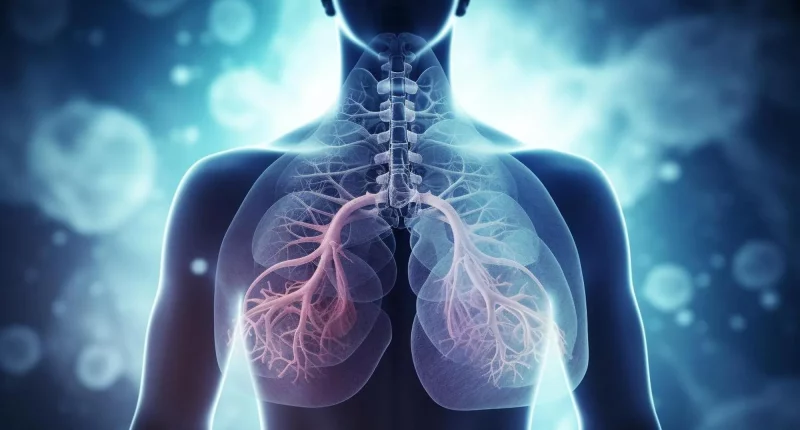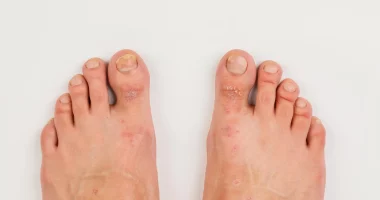Bronchiolitis is an infection of the lung that mainly affects babies during fall and winter, though adults can get it too. It causes problems in the smaller airways of the lungs and can be serious, needing medical care.
Doctors usually find bronchiolitis in kids under 2 years old. It’s estimated that about 11-15% of babies get it in their 1st year of life.
Symptoms
Bronchiolitis starts with symptoms similar to a common cold: fever, a runny nose, and a cough. At this early stage, it’s hard for doctors to distinguish between a cold and bronchiolitis, so there may be no immediate need to see a doctor.
After about 48-72 hours, the infection moves into the lower airways, like the bronchioles, causing swelling and fluid buildup. This progression leads to more severe symptoms like difficulty breathing. It’s usually at this point that people seek medical help. During a physical exam, doctors listen for wheezing, crackling, or rattling sounds in the lungs.
Symptoms can vary widely in severity. Some infants may only show mild signs such as fast breathing, while others, especially those with blue-tinted lips or skin, may have more serious symptoms. Adults can also get bronchiolitis, usually from viruses, but their signs are typically few severe than those in babies.
In rare cases, bronchiolitis can lead to respiratory failure in infants, which is life-threatening and needs immediate hospitalization. However, this is rare in healthy, full-term babies.
Bronchiolitis symptoms typically last about 7 to 10 days.
Causes
Bronchiolitis is primarily caused by a virus known as respiratory syncytial virus (RSV), which is the most common culprit. Infants infected with RSV can develop severe symptoms requiring hospital care. Adults can also get RSV, but hospitalization is rare.
Other viruses besides RSV can also lead to bronchiolitis. These include the human rhinovirus (which causes the common cold), human metapneumovirus, coronaviruses, parainfluenza viruses, and adenovirus.
It’s not uncommon for infants with bronchiolitis to have multiple viruses in their airways—about 30% of cases involve dual infections. Doctors typically do not routinely test to identify the specific virus causing the infection.
Risk factors
Certain groups are at higher risk of developing severe bronchiolitis symptoms. Premature babies born before the 32nd week of pregnancy and infants younger than 3 months are particularly vulnerable.
Additionally, babies and toddlers with certain health conditions face increased risk. These include neuromuscular disorders that affect breathing, chronic lung conditions, congenital heart disease, and immunodeficiency disorders. These conditions can make bronchiolitis more severe and may require closer monitoring and medical intervention.
Treatment
Treatment for bronchiolitis depends on several factors, such as the person’s age, overall health, and the seriousness of their symptoms.
Doctors primarily provide supportive care for bronchiolitis, which involves closely monitoring the individual and treating their symptoms as needed. Ensuring proper hydration and managing fever with medications are typical approaches.
In cases where breathing difficulties are significant, oxygen therapy may be necessary to help improve oxygen levels in the blood.
Severe cases of bronchiolitis can lead to hypoxia, where the body’s tissues do not receive enough oxygen, potentially damaging organs. Intensive care becomes crucial for managing severe hypoxia, focusing on maintaining open airways and increasing oxygen levels.
For infants with mild to moderate symptoms who do not require hospitalization, doctors may suggest nasal saline solutions to clear upper airways, antipyretic medications like acetaminophen to control fever, or using a humidifier to ease breathing.
Preventive measures can also play a role in managing bronchiolitis. Some infants, particularly those at high risk, may benefit from preventive immunization with palivizumab also known as Synagis. This is recommended for premature babies born before the twenty-ninth week of gestation, infants with specific kinds of congenital heart disease, or those with chronic lung disease due to premature birth. Immunization typically involves up to five doses administered during the RSV outbreak season, which typically runs from late fall to early spring.
After the 1st year of life, infants generally become less susceptible to severe bronchiolitis. Depending on their condition, some infants may require additional doses of palivizumab in subsequent RSV seasons.
When to consult a doctor
It’s common for parents or caregivers to initially treat a baby’s cold symptoms at home without seeing a pediatrician right away, as doctors can’t cure the common cold but can recommend symptom relief measures.
If a baby’s symptoms worsen after 2-3 days or they begin to have difficulty breathing, it’s crucial to seek medical attention promptly, either by visiting a doctor or going to the emergency room. Early medical intervention is essential for ensuring effective supportive care and promoting a swift recovery.
Infants born very prematurely or those with specific basic health conditions are at increased chance of developing severe bronchiolitis, especially from respiratory syncytial virus. For these vulnerable infants, doctors may recommend preventive immunization to reduce the risk and severity of bronchiolitis.
Outlook
Research indicates that among infants, the mortality rate for bronchiolitis ranges from 0.5% to 7%. This variability in mortality rates is often influenced by different risk factors for infants and the varying availability of intensive care units in different countries.
Fortunately, with prompt diagnosis and proper treatment, most people who are affected with bronchiolitis recover fully without lasting effects.
For infants, ensuring they receive enough fluids and supportive care is crucial. Typically, symptoms should start improving within 2 to 3 weeks with these measures in place.
Summary
Bronchiolitis is a lung infection common in infants during fall and winter and also affects adults. Symptoms mimic a cold initially, worsening after 2-3 days with breathing difficulties often requiring medical attention. Respiratory syncytial virus (RSV) is the main cause, though other viruses can contribute. Treatment focuses on supportive care, oxygen therapy if needed, and intensive care for severe cases. Prevention includes immunization for high-risk infants. Most recover fully with early diagnosis and proper care, with symptoms typically improving within 2-3 weeks for infants receiving adequate hydration and support.
External links









